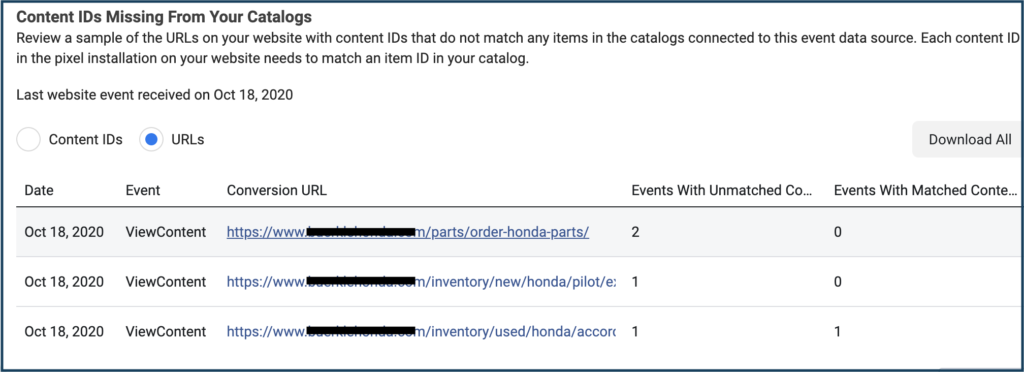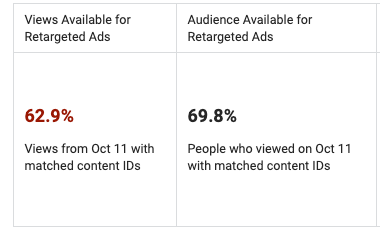
New Facebook Changes to Catalog Match Rate — Auto Marketers, Pay Attention!
Auto dealers, listen up. Facebook has made some changes to how it reports on your inventory catalog’s health and performance. Do you know what to look for?
In early October 2020, Facebook made an update to its catalog item match rate. Instead of basing the match rate on the number of items, the match rate is now based on the number of pixel events.
This may result in a much higher event-to-product ratio for your dealership’s catalog match rate.
While we do have a suggestion for eliminating some of that extra event noise (keep reading!), auto marketers will likely need to get used to seeing a lower event-to-item match rate when checking the health of their automotive Facebook catalogs.
But, first things first . . .
If you already know how to take care of your Facebook catalog and understand why you should care about this update, jump to this section.
Why Should You Care About Your Facebook Catalog Match Rate?
We know the technical side of your automotive Facebook catalog can be confusing.
But that certainly does not mean you should ignore your Facebook catalog — no matter what types of products you’re advertising.
With the teamwork of your inventory feed, Facebook catalog, and events from the Facebook pixel on your website, you have a chance to communicate with your most qualified leads at an integral part of their buyer’s journey.
Don’t miss it by failing to pay attention.
What You Lose to an Unhealthy Catalog
There is a slew of things that can go wrong with a Facebook product catalog, any of which can negatively impact your dealership’s key performance indicators (KPIs) and your ability to close a lead.
Here are a couple of scenarios to consider.
Scenario One
Moira is ready to upgrade her family’s old Lincoln Continental. She’s been browsing new sedans on the website of the local dealership, Ray’s Auto.
She finds a new model that she really likes. When Moira views the vehicle description page (VDP), the Facebook pixel fires.
Then, Moira gets distracted. She goes on her with week, and the vehicle is no longer top of mind.
Meanwhile, the Facebook pixel event from the Ray’s Auto website is properly connected to its Facebook catalog. This website event matches with the appropriate product in the catalog — the same sedan that caught Moira’s eye.
Several days later, Moira is on Facebook, catching up on her celebrity gossip. Suddenly, right in her news feed is the same exact vehicle she fell in love with last week. It’s once again on her mind — and, seeing that it’s still available, she calls Ray’s Auto to schedule a test drive.
Scenario Two
Again, Moira views a VDP on the Ray’s Auto website, and the Facebook pixel fires.
However, Ray hasn’t checked in on his Facebook catalog in a while, so he doesn’t know that something is wrong. The Facebook pixel event cannot be matched with a product in the catalog. This could be due to any number of reasons, such as:
- The last inventory feed upload to the catalog was not successful.
- The vehicle photos from the inventory provider aren’t coming through correctly.
- Due to a website change, the VDP URLs in the inventory feed are wrong.
Because of this catalog issue, Moira never sees the vehicle when browsing Facebook. Her husband finds a great deal at a different dealership a couple of weeks later.
Ray fails to gain Moira’s business because he wasn’t paying attention to his Facebook catalog match rates. But not only that, he’s also losing the attention of many other qualified car shoppers.
And in a business where every lead matters, indifference toward your Facebook catalog health is not worth the risk.
Note: The above examples were written before Apple released iOS14, which places some limitations on retargeting capabilities.

How to Take Care of Your Facebook Catalog
You know that it’s important to showcase on Facebook as many of the vehicles on your website as possible. Keeping an eye on your catalog will enable you to do this.
Ask Your Agency About It
If you’ve hired a digital marketing agency to create your Facebook catalog and run your automotive Facebook ads, make sure they are on top of checking your catalog’s health.
At 9 Clouds, we examine each of our Facebook ad partnered dealers’ catalogs at least once a month to ensure that they are in good health and that their Facebook spend delivers the most return possible.
Take Responsibility Yourself
Is your dealership running Facebook campaigns without the help of an agency? Our free Facebook Catalog Health Checklist (2nd Edition) is for you.
This free checklist will teach you how to:
- Confirm your products are populating as expected.
- Check that your last product upload was successful (and troubleshoot if it wasn’t).
- Verify that your website conversions are firing correctly.
Grab your free copy of the updated checklist!
Back to the Match Rate Update
Now that we’re all on the same page about catalog health, let’s circle back to the October 2020 match rate update.
Before: Catalog Item Match Rate
Previously, the match rate was called “catalog item match rate” and was calculated by the percentage of products that matched with a pixel-based “View Content” event. So, simply put, if you had one product in your catalog, and there were 200 website views / pixel events on that product, you would expect to see that product match with 200 events in the catalog.
Here’s a Scenario to Demonstrate the Catalog Item Match Rate:
Roland is browsing trucks on your dealership’s website. He views 11 search result pages (SRPs) and nine VDPs. In the catalog, all nine vehicles are matched with a VDP event. That’s a 100% catalog item match rate for Roland’s activity.
With a full inventory of products, we used to expect this catalog item match rate to be between 95 – 100% across our automotive clients.

This is an extremely simplified explanation of how the catalog item match rate used to work on an SRP and a VDP.
Now: Event-To-Item Match Rate
As of October 2020, the match rate is called “event-to-item match rate.”
With this update, the percentage is now calculated by the total number of website events compared to the number of products in the catalog. A website event refers to each time an attempted “View Content” event occurs — a combination of the Facebook pixel and the Facebook API firing to determine whether or not a person viewed a product containing an ID.
Navigate to the Events tab in Catalog Manager to see your event-to-item match rate.
This event can happen on each page of your website, even non-VDP pages lacking a product and, subsequently, a positive “View Content” event.
So, say you have 500 events, but only 100 of them are VDP views with a vehicle that’s in your product catalog. That gives you an event-to-item match rate of just 20% — even if all of those products from the 100 VDP pages were matched correctly in the catalog.
Here’s a Scenario to Demonstrate the Event-to-Item Match Rate:
Roland is browsing trucks on your dealership’s website. He views 11 SRPs and nine VDPs. That’s 20 website events. If all nine vehicles he viewed are able to be matched with a product in the catalog, Roland’s activity gives an event-to-item match rate of 20:9, for a percentage of just 45%.
Compared to the first scenario, that number seems a lot scarier — but everything is still operating correctly.
Time to Utilize Critical Thinking!
Keep in mind that there are many events occurring on your website, including SRP views, image views, video views, service page views, and more. Plus, there are likely several entities tracking different events on your site, like your OEM and third-party vendors.
All of these events are now reflected in your catalog.
This is unfortunate because when it comes to retargeting product IDs (vehicles) to events, all these events make a lot of extra noise when checking your catalog performance. In fact, it’s not a very helpful update on Facebook’s part.
Before, the catalog item match rate provided clarity to a potential problem with your catalog. Now, if you suspect an issue, you’ll need to don your critical thinking cap and do some digging.
For example, take a look at your URLs with unmatched content IDs. Comb through them. Are any of them VDPs? Is it logical that the event would not match with a product?

In this image, the first event is a URL for a parts landing page. We would not expect this event to match with a product in the catalog. Noise!
With this change, it may now be more helpful to examine the number of events matched on a daily basis, looking for consistency. Watch the bottom number of “Events Matched” in the example below.
What You Should Expect
Now, when checking your Facebook catalog’s health, you’ll likely see a much lower event-to-item match rate than you did with the previous catalog item match rate. But, there’s no longer a target percentage that all advertisers should expect to hit, as there was before.
This is okay, as long as you know what’s normal for your dealership.

For example, if you’ve determined after a few months that your event-to-item match rate is typically around 65%, you’ll want to investigate if it suddenly drops well below that.
What You Can Do to Eliminate Some Event Noise
To clean up some of this extra event noise, you can audit your Facebook events to make sure they only fire on successful VDP views. This can help decrease the overall number of events, which improves the event-to-item match rate percentage.
This doesn’t actually change what’s happening in the catalog, but it provides a slightly less scary rate.
Not sure how to do this? We can help.
A plethora of event traffic in your catalog may also be an indication that it’s time to audit the events, tags, and pixels on your website. What can you clean up? Can you remove pixels from vendors you’re no longer working with?
Stay Healthy!
Your automotive inventory ads will perform best when everything is operating correctly in the background.
Now that you know what to look for when performing a Facebook catalog health check, you can be confident that you’re reaching the right people at the right time in their buying journey — with the right vehicle.
This can be hairy stuff, so let us know if we can be of any assistance by scheduling a free one-on-one digital marketing assessment for your dealership.
Otherwise, snag the second edition of our Facebook Catalog Health Checklist, and advertise on!





